Jigme Tenzin
This project aims to generate species-specific ecological baseline information on Nanorana leibigii (Gunther, 1860), assess species richness and address current and future threats through community-based conservation initiatives in the Simkhar River and its tributaries.

Man with Himalayan Bull Frog.
Simkharthang is located at an altitude of 1500-2500m above the sea level amongst the cool broad leaved forest and sporadic bamboo clumps. The river flowing through Simkharthang is known as Simkharchu Khola and is fed by two main tributaries called as Pakhola and Simchukhola that ultimately drain to Maukhola, a major river in Gelephu Dungkhag under Sarpang Dzongkhag. Nanorana leibigii is found within the two tributaries including the Simkhar river.

Leptobrachium bompu.
However, recent constructions of farm roads and electric transmission lines have threatened the habitat of the species. Lacks of awareness on the ecological importance of the species by the developmental authorities and the local people have led to over exploitation of the species which if not controlled could lead to local extinction. Therefore, intervention through this project has become very important.
With this project, the status of the species will be studied and necessary control measures to save the species will be put in place. Visual encounter survey and time-constraint search techniques will be used to collect the information on the species. The project will also look into the species richness, diversity and other aspects of the habitat in which this species thrive.
Information on habitat of the species like total dissolved solid (TDS), Electric conductivity (EC), Ph and temperature etc. using Digital Hinna instruments will be collected for understanding the species. The project would form a local “Nanorana leibigii conservation group” to save the species by convincing the local residents after studying the habitat and the species with this project in its natural home range in-situ.